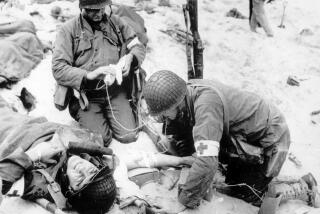Looking Back on Breast Cancer
- Share via
A few years ago when covering for a fellow physician, I met Mrs. L., a 77-year-old woman hospitalized for pneumonia. When I went to examine her lungs, I was greatly surprised. Not only was she missing both breasts, but also much of her breastbone and left rib cage. I could practically see her heart pumping. It was separated from the outside world only by a layer of skin.
American surgeons in the 1950s often performed a highly disfiguring operation--the extended radical mastectomy--for women with cancers of the inner half of the breast. Removal of breastbone and ribs, in addition to the breast and chest wall muscles, enabled surgeons to take out as many cancer cells as possible. But having read about an operation was not the same as meeting someone who had experienced it.
I asked Mrs. L. about her breast cancer. As expected, she told me that in 1954, she had noted a lump in the inner portion of her left breast and then undergone surgery. In 1978, doctors removed her right breast for a second cancer. She told me I could read about it in her chart.
So I did, encountering a vivid story. As was routine in the 1950s, the biopsy of Mrs. L.’s lump and her subsequent extended radical mastectomy had occurred during the same operation. She had awakened to learn both that she had cancer and that doctors had removed her breast and much of her chest wall. Mrs. L. was in considerable pain for days, and although she had signed a consent form, she was distressed about what had happened. “Why didn’t the head nurse tell me I was going to have my breast off,” she had asked, “so I could have gotten myself prepared for the thing?”
When I made rounds the next day, I asked Mrs. L. about being a 40-year survivor of breast cancer. She seemed very pleased with her care. For one thing, Mrs. L. had loved her doctors. She recalled how proud they had been when she did not experience any postoperative arm swelling, a common complication of radical breast surgery. In fact, the old chart contained photographs of a young Mrs. L., wearing pearls and performing arm exercises. I gently mentioned what I had read, that it appeared she had been in a lot of pain and had been quite upset about her extensive surgery. Mrs. L did not deny this but did not seem too concerned. “Those radicals work,” she informed me. “Either you want to live or to die.”
I knew from my research that most surgeons stopped performing extended radical mastectomies in the 1960s because the operation provided no better survival than less extensive procedures. Indeed, Mrs. L.’s pathology report showed that her cancer had not spread beyond her breast. But I didn’t tell her that she would have survived even if the surgeons had removed only her breast or perhaps only the lump.
One characteristic of modern breast cancer therapy is that doctors routinely treat what may not be there. Thus, radiotherapy and chemotherapy are often administered based on the assumption that invisible cancer remains after the breast lump has been removed. In this sense, treatment today is not all that different from what Mrs. L. received. Nor are the responses of survivors, who understandably want to think that the “extra” therapy saved their lives.
This same phenomenon characterizes recent efforts at prevention. Today, women may take pills, such as tamoxifen, to lower their future risk of breast cancer. They may also choose genetic testing, which can identify women with a very high likelihood of developing the disease.
For their peace of mind, some women who test positive for genetic mutations are even undergoing preventive breast removal. But as Mrs. L.’s case reminds us, many of these operations will not prolong or save lives. That is, the women who choose them may never, in retrospect, have developed breast cancer, let alone have died from the disease.
Fortunately, one thing has chanced since the 1950s. Patients today should never awake from disfiguring breast operations that physicians have chosen for them. It is women themselves who can--and should--decide which risks are and are not acceptable.
*
Dr. Barron H. Lerner, a physician and historian at Columbia University in New York, is the author of “The Breast Cancer Wars” (Oxford University Press, 2001). He can be reached at bhl5@columbia.edu.






